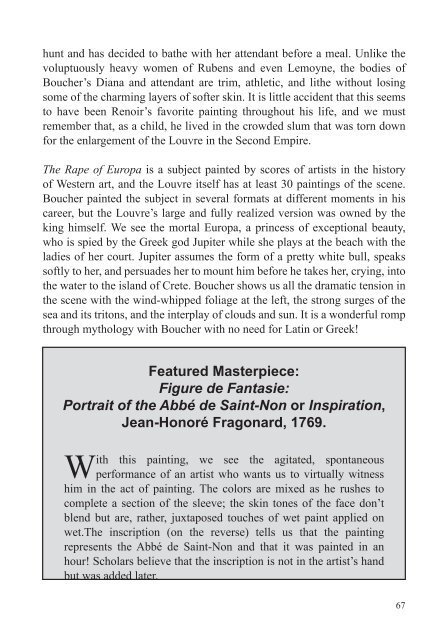You also want an ePaper? Increase the reach of your titles
YUMPU automatically turns print PDFs into web optimized ePapers that Google loves.
hunt and has decided to bathe with her attendant before a meal. Unlike the<br />
voluptuously heavy women of Rubens and even Lemoyne, the bodies of<br />
Boucher’s Diana and attendant are trim, athletic, and lithe without losing<br />
some of the charming layers of softer skin. It is little accident that this seems<br />
to have been Renoir’s favorite painting throughout his life, and we must<br />
remember that, as a child, he lived in the crowded slum that was torn down<br />
for the enlargement of the <strong>Louvre</strong> in the Second Empire.<br />
<strong>The</strong> Rape of Europa is a subject painted by scores of artists in the history<br />
of Western art, and the <strong>Louvre</strong> itself has at least 30 paintings of the scene.<br />
Boucher painted the subject in several formats at different moments in his<br />
career, but the <strong>Louvre</strong>’s large and fully realized version was owned by the<br />
king himself. We see the mortal Europa, a princess of exceptional beauty,<br />
who is spied by the Greek god Jupiter while she plays at the beach with the<br />
ladies of her court. Jupiter assumes the form of a pretty white bull, speaks<br />
softly to her, and persuades her to mount him before he takes her, crying, into<br />
the water to the island of Crete. Boucher shows us all the dramatic tension in<br />
the scene with the wind-whipped foliage at the left, the strong surges of the<br />
sea and its tritons, and the interplay of clouds and sun. It is a wonderful romp<br />
through mythology with Boucher with no need for Latin or Greek!<br />
Featured Masterpiece:<br />
Figure de Fantasie:<br />
Portrait of the Abbé de Saint-Non or Inspiration,<br />
Jean-Honoré Fragonard, 1769.<br />
W ith this painting, we see the agitated, spontaneous<br />
performance of an artist who wants us to virtually witness<br />
him in the act of painting. <strong>The</strong> colors are mixed as he rushes to<br />
complete a section of the sleeve; the skin tones of the face don’t<br />
blend but are, rather, juxtaposed touches of wet paint applied on<br />
wet.<strong>The</strong> inscription (on the reverse) tells us that the painting<br />
represents the Abbé de Saint-Non and that it was painted in an<br />
hour! Scholars believe that the inscription is not in the artist’s hand<br />
but was added later.<br />
67







